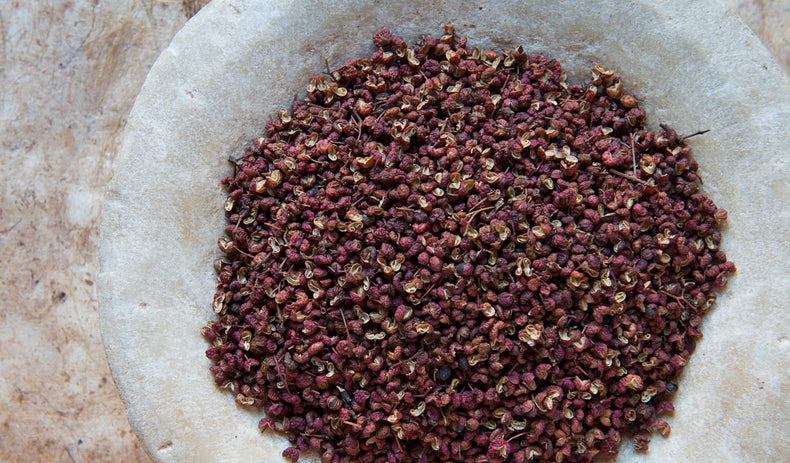Everything You Need To Know About Sichuan Pepper

“China is the place for food, but Sichuan is the place for flavour” according to an age-old proverb. And one of the famous flavours in this south western Chinese province is the native Sichuan peppercorn, known for its mouth-numbing qualities.
They release ‘ma’ spiciness which numbs the mouth and awakens the palate, unlike the more-conventional ‘la’ hotness associated with chillies.
Paradoxically, Sichuan pepper is neither a pepper nor a chilli – but the seasoning comes from the prickly ash bush, which is grown on the forested hilltops of the lush province. Once the earthen-red berries have been picked, they’re laid out to dry in bamboo baskets until the skin cracks open. The seeds are discarded, and it’s the husks – shaped like miniature horse chestnuts – which are used to season food. They have a strong lemon aroma, but when bitten into, they release ‘ma’ spiciness which numbs the mouth and awakens the palate, unlike the more-conventional ‘la’ hotness associated with chillies.
Sichuan’s cuisine is one of the most distinctive in China, but it evolved as a quite literal mixing pot, influenced by neighbouring provinces. In the 1600s, Zhang Xianzhong – nicknamed ‘The Yellow Tiger’ due to the unpleasant combination of jaundice and blood-lust – invaded Sichuan and was alleged to have killed 600 million. This was unlikely, as the estimated population of China in the seventeenth century was 150 million. But the implication is that the massacre left Sichuan vastly unpopulated. So people from nearby Hunan and Guangdong moved to the lush Sichuan valleys, and brought their own culinary traditions with them.
Sichuan peppercorns were incorporated into the evolving cuisine. And the region quickly earned a reputation for its tongue-tingling spice. So much so, that in the mid-seventeenth century the Qingxi Township, south west of Sichuan’s main city of Chengdu, was ordered to pay an annual peppercorn tribune to the Imperial Court. The much-resented tax was abolished at the start of the twentieth century. But the Qingxi Tribute Pepper is now referred to with an element of pride in the area – proof that their Sichuan pepper was requisitioned because it was considered to be best in China.
More recently, waves of Chinese emigration have seen Sichuanese cuisine spread worldwide. But Sichuan pepper hasn’t always been as warmly welcomed as other Sichuan ingredients. In 1968, America banned the import because officials were worried that the peppercorns carried ‘citrus canker’, and would infect local lemon crops. Such was the outrage amongst Sichuanese communities and Sichuan food-lovers, a black market emerged, and the spice was backhanded from one cook to another. In 2005 the ban was overturned though, and the popularity of Sichuan peppercorns has continued to grow ever since – creeping into more mainstream dishes in Britain and America.
The best way of experiencing the tongue-tingling sensation of Sichuan pepper is to bite into the husk and chew it a couple of times before spitting it out. The more conventional way to serve it though, is to grind the husks in a pepper mill or pestle and mortar, and use the spice as a seasoning. Mapo Tofu is a traditional dish which is topped with a generous dusting of Sichuan peppercorns. It’s served in Sichuanese restaurants worldwide. But if you’re visiting the province, try out the cheap Chengdu chain ‘Chen Mapo Tofu’, or visit the cult diner, Tiantian Kao Ya, for a Sichuan pepper experience in Sichuan.
Regular:
Try Sichuan chilli bean paste, for more signature tongue-tingling heat of the region.




